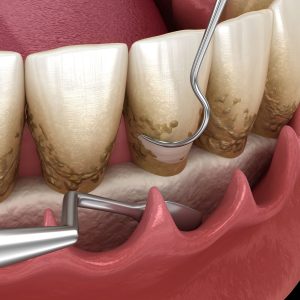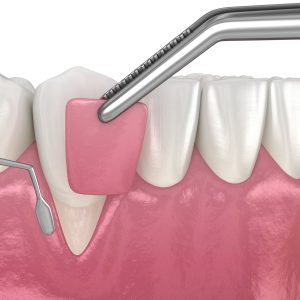Maintain Optimal Gum Health In West Sayville, NY
Your gums are the foundation of your teeth, and they need to stay healthy so you can eat, speak, and smile with confidence. Unfortunately, periodontal disease is all too common and easy to miss. If you’re looking to treat symptoms of gum disease, West Sayville dentist Dr. Richard Sigismondi provides top-quality periodontal therapy. Learn what periodontal therapy is, how it can benefit your oral health, and what makes Dr. Richard Sigismondi stand out as a leading periodontist in West Sayville, NY.
What is Periodontal Disease?
Periodontal disease, also known as gum disease, is primarily caused by the buildup of plaque on the teeth and gums. Plaque is a sticky film of bacteria that forms on the teeth, and if it is not removed through brushing and flossing, it can harden into a hard substance called tartar. Tartar buildup can lead to inflammation and infection of the gums, which can ultimately cause damage to the bone and connective tissue that support the teeth.
Symptoms of Periodontal Disease
Symptoms of periodontal disease can vary depending on the severity of the condition, but some common signs include:
- Bleeding gums during brushing or flossing
- Swollen or tender gums
- Receding gums
- Persistent bad breath or a bad taste in the mouth
- Loose teeth or changes in bite
- Changes in the fit of dentures or other dental appliances
It’s important to note that periodontal disease can develop without any symptoms in the earlier stages, which is why regular dental checkups and cleanings are so important. If you suspect you have symptoms of periodontal disease, contact our West Sayville dentist and schedule a consultation.
What is Periodontal Therapy?
Periodontal therapy refers to multiple dental treatments that focus on treating gum disease. Periodontal therapy is essential for preventing and treating gum disease, which can lead to tooth loss and other serious health problems. It also helps improve oral health by keeping teeth and gums healthy and strong.
What Are the Benefits of Periodontal Therapy?
Periodontal therapy has many benefits, including:
- Maintaining Healthy Teeth and Gums: By removing plaque and tartar buildup that causes inflammation and bleeding, periodontal therapy helps maintain healthy teeth and gums.
- Improving Overall Oral Health: By reducing inflammation and infection in the gums, periodontal therapy can also improve overall oral health and reduce the risk of other dental problems such as cavities and bad breath.
- Preventing Future Dental Problems: One of the major benefits of periodontal therapy is that it can prevent future dental problems. By treating gum disease and maintaining healthy teeth and gums, patients can avoid more extensive dental procedures in the future.
- Reducing the Risk of Tooth Loss: Periodontal therapy can reduce the risk of tooth loss by addressing the underlying gum disease and promoting healthy gums. When gum disease is left untreated, it can progress to the point where the tooth becomes loose and eventually falls out.
- Boosting self-esteem: Gum disease can cause visible symptoms such as swollen, bleeding gums and bad breath, which can negatively affect a person’s self-esteem. By treating gum disease and promoting healthy gums, periodontal therapy can improve a person’s appearance and boost their self-confidence.
- Saving Money: Preventive dental care such as periodontal therapy can save patients money by avoiding more extensive and costly dental procedures such as tooth extractions, dental implants, and gum surgery.
- Enhancing Quality of Life: By reducing pain, discomfort, and the risk of tooth loss, periodontal therapy can enhance a person’s quality of life and allow them to eat, speak, and smile with confidence.
What Can I Expect During a Periodontal Therapy Appointment?
During a periodontal therapy appointment with Dr. Richard Sigismondi, you can expect a thorough examination of your teeth and gums. Dr. Sigismondi will use state-of-the-art technology to diagnose any gum disease and develop a personalized treatment plan based on your specific needs and goals. He’ll also explain the treatment process in detail and answer any questions you have.
Available Periodontal Therapy Options
At our West Sayville dental office, we use state-of-the-art technology and techniques to diagnose and treat gum disease. Common periodontal therapy options include:
- Scaling and root planing
- Laser gum therapy
- Antibiotics
- Gum Grafting
Scaling and Root Planing
Scaling and root planing is a non-surgical treatment that involves the removal of plaque and tartar from the tooth surface and below the gum line. The scaling process removes the plaque and tartar, while the root planing process smooths the tooth roots to prevent future buildup. Scaling and root planing are typically the first lines of treatment for mild to moderate cases of periodontal disease.
Laser Gum Therapy
Laser gum therapy is a minimally invasive procedure that uses a laser to remove diseased tissue and bacteria from the gums. The laser also helps to stimulate the growth of new, healthy tissue. Periodontal laser therapy is typically used for more advanced cases of periodontal disease and can be a good option for patients who are looking for a less invasive treatment option.
Antibiotics
Antibiotics are medications used to treat bacterial infections by either eliminating or slowing down the growth of bacteria. In some cases, your West Sayville dentist may prescribe antibiotics to help treat periodontal disease. Antibiotics can be administered orally or applied topically to the gums and can be used in conjunction with other treatments.
Gum Grafting
Gum grafting is a surgical procedure used to treat gum recession, which can be caused by periodontal disease. When gums recede, the roots of the teeth become exposed, leading to sensitivity, pain, and an increased risk of tooth decay. During a gum grafting procedure, tissue is taken from the patient’s mouth or a donor and grafted onto the affected area of the gum line. This not only covers the exposed roots but also helps to prevent further gum recession and can improve overall gum health.
Frequently Asked Questions
Most periodontal therapy procedures are not painful, and your dentist may use a local anesthetic to ensure your comfort during the treatment. After the treatment, you may experience some discomfort or sensitivity, but this can be managed with over-the-counter pain relievers.
The length of time required for periodontal therapy depends on the severity of the patient’s gum disease. Patients with mild gingivitis can expect their therapy to last only a few days to a week, whereas those with more severe periodontitis may require several appointments over a few months.
It is important to note that while periodontal therapy can halt the progression of gum disease, it’s not a cure, and patients will need to continue practicing good oral hygiene habits to prevent it from returning.
Like any medical procedure, periodontal therapy comes with some risks. Patients who undergo scaling and root planing may experience some discomfort or sensitivity in the treated areas, and there’s a small risk of infection or bleeding. However, these risks are minimal, and the benefits of periodontal therapy far outweigh them.
Maintaining good oral hygiene habits is the key to preventing gum disease from returning after periodontal therapy. Patients should brush their teeth twice a day, floss daily, and schedule regular dental cleanings to keep their teeth and gums healthy. Additionally, patients should avoid smoking or using any tobacco products, as these can increase their risk of developing gum disease.




